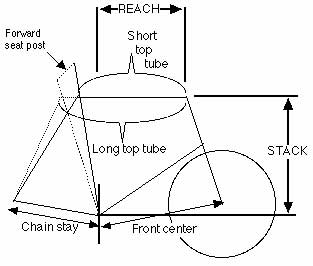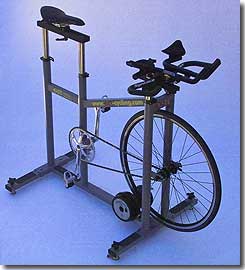Stack & Reach Primer: Chapter Two
Let us consider two tri-geometry bikes, made by competing manufacturers. Both come in 700c in 58cm. Both bikes have 76-degree seat angles. Each of these bikes has a top tube measurement of between 58cm and 58.5cm. Carbon copies, right?
In actuality, if you owned one of these bikes and moved the parts over to the other's frame, you'd be in for a big surprise. One has a head tube length of 13cm and it's built to accept an integrated headset, which means most of the headset hides inside the head tube. The other has a 17.5cm head tube, and does not use an integrated headset. The significance of the headset is that a standard headset adds about 2cm of stack above the head tube. Therefore, your stem is going to sit about 7cm higher on one than on the other.
And this is not a hypothetical construct, these are two bikes that until recently were offered for sale in these geometries. Since they both measured 58cm, with almost identical top tubes and seat angles, only a closer inspection would've uncovered how incredibly differently these bikes fit. But, if you knew the stack and reach of these two bike frames you'd be able to tell precisely what the differences were and be prepared for them.
Simply as a function of it, the seat angle makes absolutely no difference in any of this. Let's take Trek's Team Time Trial bike as an example. Its virtue is in its very low front end. It's head tube measures 11.3cm in its large size. But it's got a very slack seat angle of 73.7 degrees. The nose of my saddle needs to be straight over the bottom bracket on my tri bike. At 73.7 degrees, and at 80cm of seat height, my saddle is going to be roughly 7cm behind the BB. Obviously, I can't ride this bike in triathlons. Or can I?
If I find the right set-back seat post, and flip it around forward, and move the saddle forward on its rails, perhaps I can find this 7cm for forward saddle movement. All I really care about is, once it's there, is the bike going to fit me from the BB forward? It's certainly low enough for me, but is it long enough?
In fact, it won't work for me very easily. While it's low enough — it's got a small enough stack — it hasn't got enough reach. You might find this funny, since it's got a 57.7cm top tube length and my own tri bike only has 56.0cm of top tube. But in fact the reach of this bike is quite small, because its top tube starts so far behind the BB. If you normalized the seat angle at 78 degrees — that is, if you draw an imaginary line through the BB at a 78 degree angle, and measured the to tube length of the Trek at the point it intersected with this imaginary line — that 57.7cm top tube might only be 52cm or 53cm. It was this problem that caused Trek to revamp the design, and come out with the much better designed Equinox TTX.
Accordingly, seat angle is immensely important to the question of your preferred rider position, but it is theoretically immaterial to the question of bike fit, because you can move the saddle all forward or backward to find your saddle's desired "point in space" relative to the bottom bracket. What you cannot change is the head tube top's orientation to the bottom bracket. Or, to put it another way, the way you add to a frame's stack is to add headset spacers. The way you add to a frame's reach is to put on a longer and longer stem. But you also change the frame's structural integrity when you do so, and you also change its handling characteristics. So if you want a frame to handle properly, you'll start with one that has a stack and reach that's as close to appropriate as possible.
But let's go back to seat angle for a moment. No, this is not an important issue on paper, and it hasn't been so until recently. The reason it's important now is that most desirable tri bikes have proprietary aerodynamic seat tube and post complexes, that is, you can't change out the stock OEM seat post. So the seat angle is now fairly important, in that your bike's saddle might not be able to adjust to its proper "point in space" unless the frame is fairly close to the seat angle you need.

In the adjacent diagram, you can see that your stack and reach is not going to change one iota regardless of what the seat angle is. Neither is the chainstay, nor is the front/center. If you've got a slacker angle, no big deal. A forward seat post will put your saddle in the same position. Two frames can have different seat angles and have the same stack and reach. Each will have exactly the same front-to-rear weight dispacement, as long as the chain stay and front/center are the same. They'll both handle the same, as long as the steering geometry is the same. But the seat angle becomes important today, with today's tri bikes, because you can't simply put a forward seat post on the bike — the bikes today come with posts you can't swap out.



Start the discussion at slowtwitch.northend.network